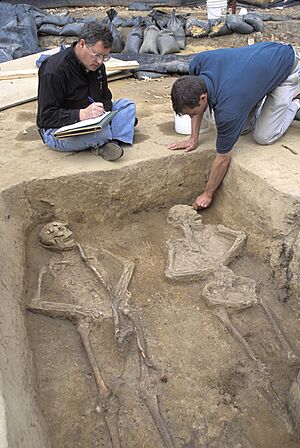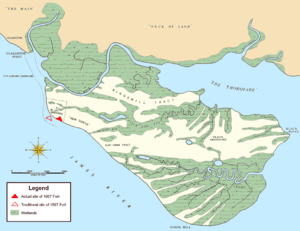Jamestown Rediscovery facts for kids
Jamestown Rediscovery is an exciting archaeological project. It explores the remains of the very first English settlement at Jamestown. This historic town was founded in the Virginia Colony way back on May 14, 1607. The project is run by Preservation Virginia.
In 1994, a famous archaeologist named William Kelso started leading the digs at Historic Jamestowne. By 1996, his team made an amazing discovery. They found the foundations of the original 1607 James Fort! People had thought this fort was lost to the James River a long time ago. The project was supposed to last 10 years. But because so many cool artifacts and so much knowledge were found, it's still going on today!
Contents
Discovering Jamestown's Past
In 1994, Preservation Virginia decided to fund a 10-year archaeology project. They called it Jamestown Rediscovery. Their main goal was to find remains from the first years of the Jamestown settlement. They especially wanted to find the earliest fortified town.
Work began on April 4 near the old church. Archaeologists quickly found early colonial artifacts. In 1996, they successfully located parts of the original 1607 James Fort's palisade. This exciting news was shared with the public on September 12 by the governor.
Later digs showed that only one corner of the first triangular fort was destroyed. In 2006, archaeologists dug up the first well found in a cellar on the site. In 2007, Queen Elizabeth II visited the site again. This was to celebrate the 400th anniversary of Jamestown. In 2010, archaeologists found the site of Jamestown's second church.
In May 2013, the project announced a significant discovery. Working with the Smithsonian Institution, they found the remains of a young English woman. She showed signs of extreme hardship during the "starving time" winter of 1609-1610. In July 2015, the team identified the remains of four important leaders of the colony. Since late 2016, the focus has moved to the Memorial Church.
What We've Learned
This long archaeological project has made many important discoveries. It has uncovered much of the fort and remains of several houses. They also found wells, a palisade wall, and graves of early settlers.
Today, visitors can see the James Fort site. They can also explore the 17th-century church tower. There's also a museum called the Archaearium. Here, you can see some of the amazing artifacts found.
Ongoing excavations have found evidence of the "Starving Time" winter of 1609/10. They also found proof of survivors arriving from the Bermuda shipwreck Sea Venture. Nearly 1.5 million artifacts have been uncovered!
Colonists' structures have been identified. These include temporary soldiers' shelters and row houses. Wells, a storehouse, and the 1608 church were also found. The original 10-year project has continued much longer. Visitors can still see archaeologists working today. They continue to uncover buildings and artifacts near the James Fort site and Jamestown Church.
Some discoveries have been named top archaeology finds by Archaeology magazine. This includes evidence from 2013 that colonists faced extreme hardship during the "starving time." The discovery of the original church inside James Fort in 2010 was also a top find. In 2015, the identification of four important settlers' graves within it was also recognized.
Finding the Lost Fort
Jamestown Rediscovery proved a long-held historical idea wrong. Many believed the original 1607 Jamestown settlement had washed into the James River. But archaeologists like William Kelso, Beverly (Bly) Straube, and Nick Luccketti used old maps and writings. They used the Zuniga Map and accounts from settlers like William Strachey, Captain Ralph Hamor, and John Smith. These helped them guess where the fort was.
After studying these sources, archaeologists found the postholes of the original fort. These were discolorations in the soil. They showed where the palisades and bulwarks once stood. As they dug more, they confirmed that the fort had not washed away. Instead, it was accidentally covered by a Confederate earthwork during the American Civil War. During this dig, the team found fort buildings, artifacts, and settlers' remains.
Amazing Artifacts
So far, the project has found over two million artifacts! Many of these are from the first few years of the settlement. Finding a well inside the fort was very important. Not just for water, but for the artifacts found inside it.
Wells that stopped working were often filled with daily trash. This gave archaeologists a chance to find many layered artifacts. Tobacco pipes, pottery pieces, and combat armor all help date the site to the early 1600s. This strongly supports that it is indeed the fort.
Curator Beverly Straube found evidence of the settlers' professions. There were goldsmiths, bricklayers, masons, and perfumers. Also tailors, fishermen, coopers, blacksmiths, glassmaker|glassmakers, carpenters, and tobacco pipe makers.
Important People Found
The Jamestown Rediscovery project has found and studied the remains of many original settlers. For example, one of the first human finds was a high-status man. He was about 19-20 years old. He died from a musket shot to his lower right leg.
Doug Owsley from the Smithsonian examined the skeleton. His skull was reconstructed to show what he might have looked like.
Later, in a cellar, they found the skull of a young woman. She was around fourteen years old when she died. The research team named her "Jane." Her identity is unknown. DNA samples were saved, but finding modern relatives is unlikely.
A grave site for an important figure was also found. The skeleton of one original colonist was separate from others. It was in a place of honor near one of the fort's gates. The person was buried in a coffin with a staff, showing leadership.
Some believe this is Captain Bartholomew Gosnold, one of the colony's organizers. Others think it might be Thomas West, 3rd Baron De La Warr. Research continues, even looking into family trees in England. But this person's identity is still a mystery.
Remains were also dug up from the chancel of the church built in 1608. This might be the first Protestant church in the New World. The men buried there were likely high-status colonists. The four individuals are possibly "Rev. Robert Hunt, the first Anglican minister; Capt. Gabriel Archer, an early leader; Sir Ferdinando Wainman, a cousin of the governor; and Capt. William West, the governor's uncle." These identifications are based on clues found at the site.
A Unique Culture
The first settlers had experience in warfare and building forts. Many had fought in the Dutch Revolt. They brought many skills and experiences. Living in Virginia and interacting with the native peoples also led to a new local culture. This is seen in artifacts like changed armor or local clay pipes.
Gallery












